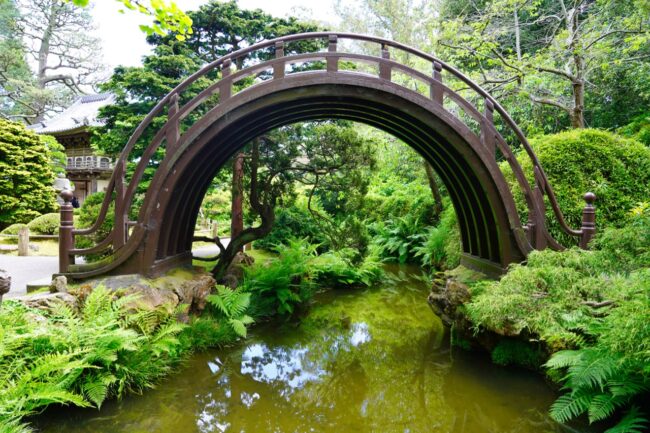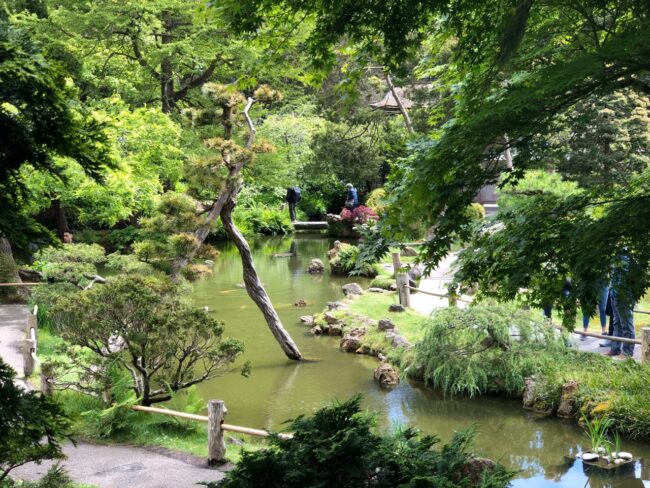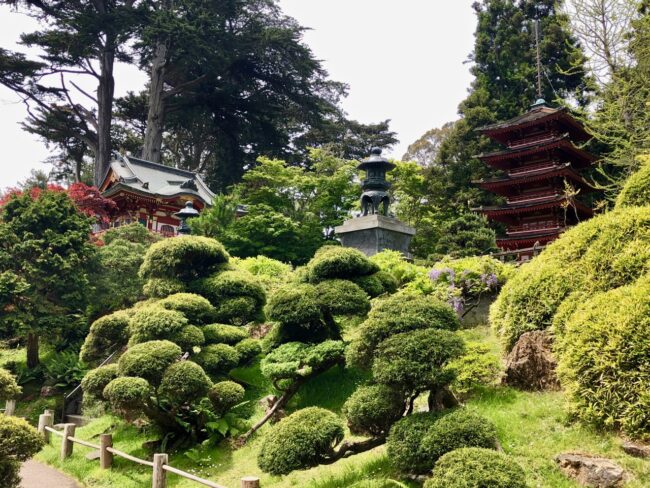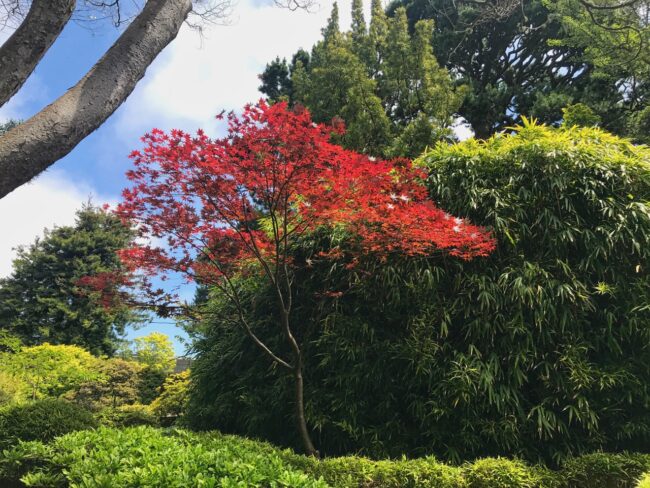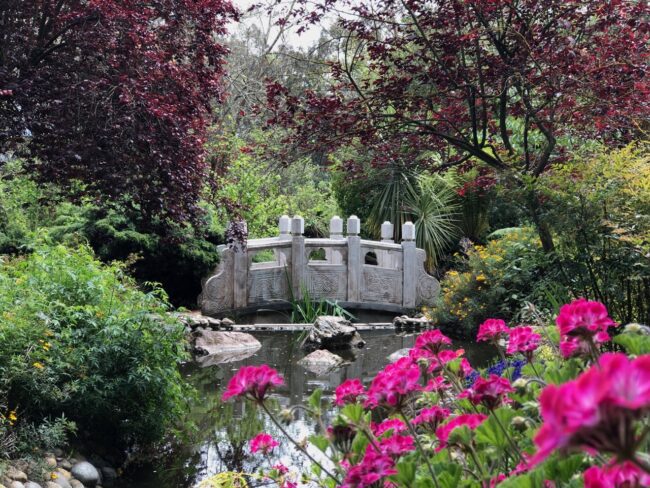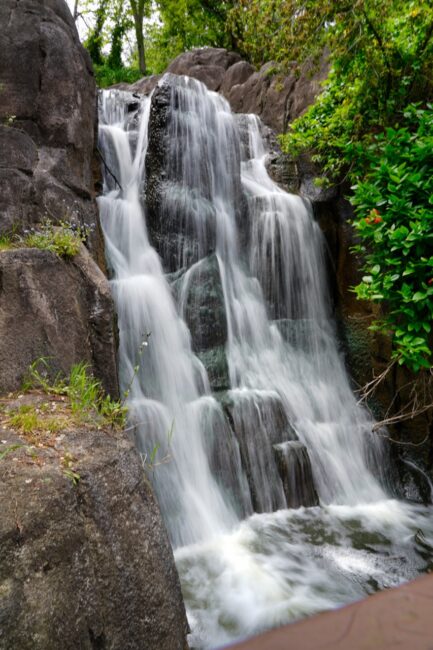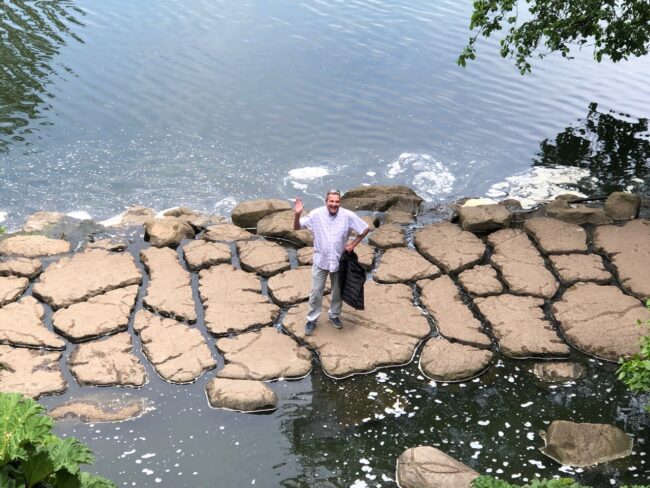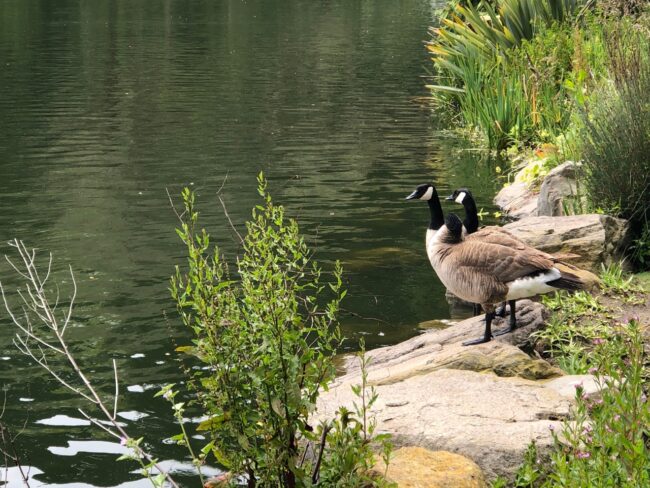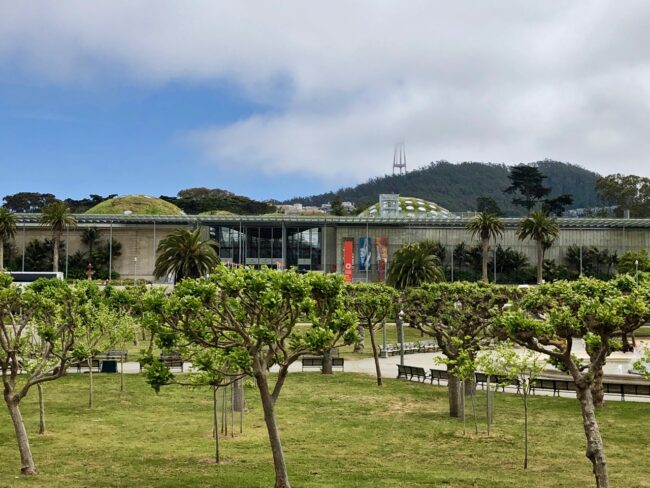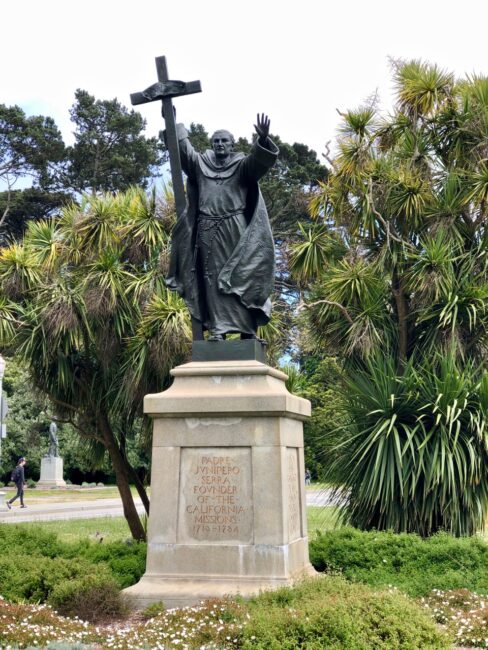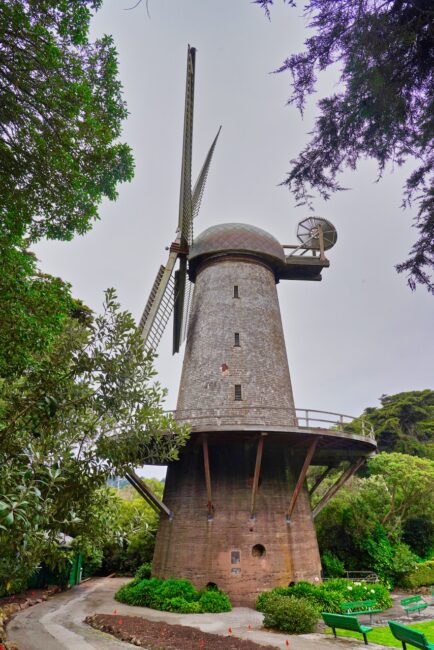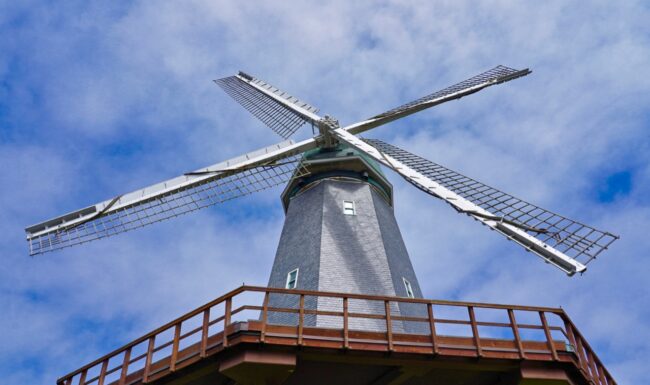
Grace Cathedral – San Francisco
May 28, 2019
Huntington Library, Art Collections, and Botanical Gardens (European Art Edition) – San Marino
August 28, 2019Three Countries In Three Hours
Golden Gate Park – San Francisco
While visiting San Francisco, my buddy Kim said, “How’d you like to visit three countries in the next few hours?” Not having brought my passport, I didn’t think it would be possible, but Kim told me not to worry. “We can do this without even leaving Golden Gate Park,” he quipped.
Scoring a fantastic parking space on JFK Drive near the DeYoung Museum, Kim and I (along with Mary and Tracy) started our journey toward our first country. Along the way, we viewed what looked like a large spider.
As the fog and clouds scuffled with blue skies, we caught a glimpse of Sutro Tower (well, part of it anyway). Sutro Tower was constructed in 1973 in an effort to help Bay Area residents receive better television reception. At first, it was considered to be an eyesore by many, but is now recognized as a Bay Area icon, although not as beloved as Steph Curry.
In a tilting-at-windmills moment, we happened upon the Miguel Cervantes Memorial. It was presented to the city of San Francisco in 1916, and it depicts Sancho Panza and Don Quixote gazing up at Cervantes.
I loved these colorful plants, but were told by the group they can be quite invasive.
There was a Monet exhibit going on at the DeYoung, which explains the mural painted on the exterior. It made quite an impression, as did this bee buzzing in the nearby flowers.
The next statue had me “hooked” at first glance. Peter Coffin’s “Pirate” is a compilation of Long John Silver from Robert Louis Stevenson’s Treasure Island, and Captain Hook from Peter Pan. Like something out of Noah’s Ark, this pirate has two parrots, two pegged legs, two hooks and two eye patches. I could just hear him say, “It’s only a flesh wound. Come back here you chicken!”
French winemaking was toasted by the bronze Poème de la vigne (Poem of the Wine), created by Gustave Doré, which was exhibited at the 1878 Paris World’s Fair. There are plenty of figures associated with the Roman God of Wine Bacchus in this 11-foot high vase. It’s been here since 1894.
It was time to enter our first country (not counting the United States). Stepping through the Main Entry Gate into a wonderland of magical scenery, we were inside the Japanese Tea Garden. Being a tea garden, I figured it had to be steeped in history.
The Japanese Tea Garden was originally conceived as a Japanese Village exhibit for the 1894 California Midwinter International Exposition, where the first fortune cookies were served (more on that later). According to the website, “When the fair closed, Japanese landscape architect Makoto Hagiwara and superintendent John McLaren reached a gentleman’s agreement, allowing Mr. Hagiwara to create and maintain a permanent Japanese style garden as a gift for posterity. He became caretaker of the property, pouring all of his personal wealth, passion, and creative talents into creating a garden of utmost perfection.”
Between 1895 and 1942, Hagiwara (who passed away in 1925) and his family “resided, cared for, and furthered the development of the Japanese Tea Garden.” In 1942, the Federal Government evicted them from their home and transported the family to an internment camp along with other Japanese-Americans. Due to anti-Japanese sentiment, the garden was renamed “The Oriental Tea Garden.”
After the Hagiwara family were relocated, the garden fell into disrepair. From the GGP website: “During wartime, many of the beautiful arrangements were destroyed or removed, sculptures vanished, and many plants succumbed from lack of care.”
Sanity returned in 1952, when the garden was renamed the Japanese Tea Garden. A plaque was installed here in 1974 for the Hagiwara family’s accomplishments.
The five-acre Japanese Tea Garden at Golden Gate Park is the oldest Japanese garden in the United States. As we meandered about, we passed by one of the numerous stone lanterns that dot the landscape.
Kim and Tracy were quite fond of the purple iris in the pond.
This guy spent a lot of time trying to rub his back. He was almost a fish out of water at times.
Everywhere we turned, there were enchanting trees, and even a lovely wisteria still blooming.
We approached a large bridge that Tracy said I should attempt to scale. Obviously, she has a larger life insurance policy on me than I surmised.
The Drum Bridge was also designed and built for 1894’s World’s Fair (shipped from Japan) and afterward was donated to the city of San Francisco. Mary braved certain death and made it to the top.
The word that best describes the Japanese Garden is “tranquil.”
Ponds, pagodas, pines, wooden bridges and stone structures mingled perfectly with the flora, fish and birds.
Everyone seemed to be at peace here.
Speaking of “peace,” in 1953, thanks to the contributions of Japanese school children, a 9,000 pound bronze lantern was purchased and offered as a symbol of friendship to the United States.
We were offered a Jon Stewart “Moment of Zen” in the Zen Garden.
You can easily lose yourself (and where you are) as you admire the plethora of different trees …
… that adorn the gardens.
Taking a look at the Sunken Garden, I was reminded of the fact that at one time the Hagiwara family had a 17-room home near this vicinity vicinity, where they resided for 48 years until they were sent to the concentration camp. It was said that “many Hagiwara family treasures were removed or destroyed.” The Sunken garden can be best seen from the Tea House terrace.
During the period from 1942 to 1949, Mr. Hagiwara’s Shinto Shrine was removed, and a Buddhist Pagoda was relocated to the spot. It was created in 1915 for the Pan-Pacific Exhibition.
It’s a spot where many people stopped to have their photos taken. We were no exception.
The ornate Japanese Temple Gate is also located nearby.
We stopped to take a look at the large bronze Buddha, presented to the garden in 1949 from the S&G Gump Company. It’s located near the eastern end of the Long Bridge and was cast in Japan in 1970.
If you’re in a tea garden, you might as well sample some tea. We stopped at the Tea House, which was refurbished in 2011. It was here that I looked at the map and tried to scope out the rest of the journey. Kim just about fell asleep as I plotted out our next move, while Mary has that look of “are you ever going to finish?”
The Japanese Tea Garden is where the first fortune cookies were served in the United States during the 1894 California Midwinter International Exposition. Baron Hagiwara first started serving them with green tea here at the Tea House. According to author Jennifer 8 . Lee (yes, that’s her name) in her book The Fortune Cookie Chronicles: Adventures In the World of Chinese Food, “the history of fortune cookies in America goes back to L.A. and San Francisco. But as a concept, they go back to Japan.” She adds this tidbit about fortune cookies, “I like to say that the Japanese invented them, the Chinese popularized them, but the Americans ultimately consume them.” Interestingly, the fortune cookies at the Japanese Tea Garden now come from Mee Mee Bakery located in San Francisco’s Chinatown. It’s a small world.
We took one more glance out at the lush gardens, and it was time to move on to our next country.
Coincidentally, we were headed for China, or more succinctly, the Chinese Pavilion. After momentarily becoming lost, a hungry squirrel took time out from his nut consumption and pointed us in the correct direction.
Along the way, we were greeted by a couple of turtles and an inquisitive bird. I asked the bird his name, and he responded, “You can call me Jay.” That’s my story and I’m sticking to it.
We also took a gander at some geese who were out for a family stroll.
Tracy then exclaimed, “Wow, check out that tree!” Looking up into the tree on an island in the lake we saw a bunch of nests full of Blue Heron.
Sitting on a bench with a telescope was a woman who knew her herons. She informed us that, “There are seven nests this year, and the chicks are seven weeks old and about four feet tall.” Tracy inquired about when and how they learn to fly and she responded that, “They start flying at ten weeks, after learning to fly by jumping from limb to limb.” She pointed out one nest that held four chicks, so the nests must be pretty large. It was fascinating to watch.
As it turned out, the woman who was disseminating all this information was Nancy DeStefanis, the so-called “Heron Lady,” who has been doing this since 1993. If you ask her politely, she might even go into her rendition of, “My Blue Heron.” (No, I’m not kidding.)
This is a beautiful area of the park (well, I guess most everything is beautiful at Golden Gate Park).
We could see the Chinese Pavilion in the distance as we gazed across Stow Lake, the largest of the park’s 10 lakes. Had we known a ghost might be around, we might have been more cautious. According to legend, a baby drowned in Stow Lake near the beginning of the 20th century. His mom tried to save him, and she perished as well. Some say she roams the banks at night and occasionally asks visitors, “Have you seen my baby?” Luckily, we were there during the day.
The Chinese Pavilion was a gift to San Francisco from its sister city Tapei, Taiwan, in 1981.
The bridge was quite photogenic, as well.
We took some stairs to get a close-up of Huntington Falls, a man-made falls that cascade down to Stow Lake.
According to the GGP website, “(John) McLaren became inspired to include waterfalls in Golden Gate Park during a hike in the Sierras with naturalist John Muir.”
After I climbed back down to the path, I realized I was alone. Our intrepid threesome had decided to climb further up Strawberry Hill (almost as many thrills as Blueberry Hill), so they took a photo of me and and then abandoned me.
Their rewards were more beautiful flowers.
I met them back at the Stone Bridge, where I took a photo of a couple enjoying a leisurely cruise.
Passing geese and some rhododendron, we headed back to the car.
The Spreckels Temple of Music was completed in 1900. Everyone from Luciano Pavarotti to The Grateful Dead have performed here.
A 19th-century statue of a Roman gladiator looks out at the California Academy of Sciences. All the while, the Sutro Tower was still trying to break through the clouds.
There were a few more statues to visit along the way, like The Apple Cider Press from 1892. This statue was originally a drinking fountain, and some say that cider flowed out of it instead of water. It was created by American Thomas Shields Clarke. Clarke studied in Paris and received a medal of honor in Madrid for this sculpture.
The bronze statue of Padre Junípero Serra was dedicated in 2007, and was the work of Douglas Tilden, whose works can be seen throughout Golden Gate Park, although none of Padre Manny Machado could be found.
Soon a statue stood in front of me, and I admit I’d never heard of this gentleman. From the Art&Architecture website I found out, “Thomas Starr King was an American and Unitarian minister, influential in California politics during the American Civil War. Starr King spoke zealously in favor of the Union, and was credited by Abraham Lincoln with preventing California becoming a separate republic. He wrote a book about Yosemite National Park, where there is a peak named after him. He died of diphtheria in San Francisco March 4, 1864.”
The pedestal is made of pink Missouri granite.
As we made it back to the car, I said to Kim, “I thought we were visiting three countries.” Kim answered, “Hang in there, soon we’ll be in the Netherlands.”
It was a relatively short drive to the Netherlands, and there in front of us was a giant windmill. Of course, after hearing renowned scientist Donald Trump’s recent speech on the dangers of wind power, I thought for sure I’d catch my death of cancer from the deadly windmill, but we pressed on.
Sadly we had just missed by about a week a dazzling array of tulips at the Queen Wilhelmina Garden …
… but there stood the North Dutch Windmill (built in 1902) that at one time (along with the Murphy Windmill) “pumped 1.5 million gallons of water daily for irrigation use to a reservoir now known as Stow Lake.”
We still had one more windmill to see, so we hopped in the car and drove to the recently restored Murphy Windmill. Constructed in 1905, the Murphy Windmill was, at one time, the largest in the world. Some contend it still is today
Fun Fact: According to Atlas Obscura, “In 1921, the daredevil Velma Tilden climbed aboard the mighty sails and held on for 25 full rotations for a prize of $25 worth of chocolates.”
That concluded our morning and afternoon at Golden Gate Park.
We had only touched a small piece of the 1,017 acre park, which incorporates 680 acres of forests, 130 acres of meadows, 15 miles of drives and 33 acres of lakes. By the time 2020 rolls around and Golden Gate Park celebrates its 150th anniversary, I hope we will be able to explore even more of this spectacular space.
Golden Gate Park
San Francisco, CA
Japanese Tea Garden
75 Hagiwara Tea Garden Drive
San Francisco, CA 94118
Hours: Daily 9 a.m. – 5:45 p.m.
Phone: 415.752.1171
Admission: Monday, Wednesday, Friday free before 10:00 am
Adult: $6.00 (Residents), $9.00 (Non-Residents)
Senior (65+) and Youth (12-17) • $4.00 (Residents) • $6.00 (Non-Residents)






















